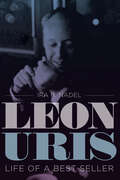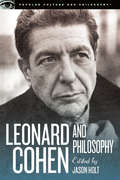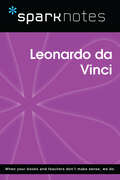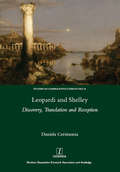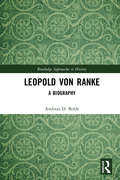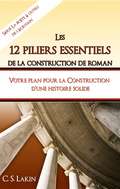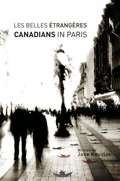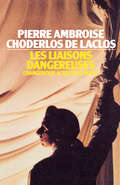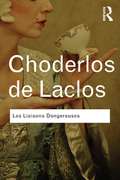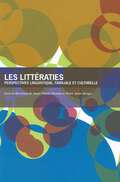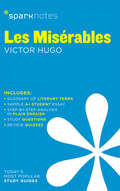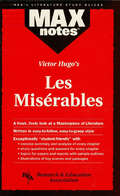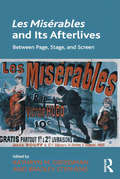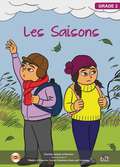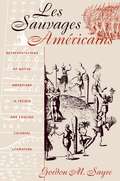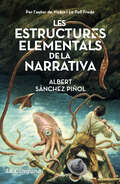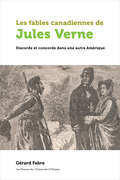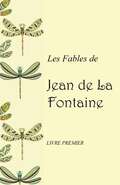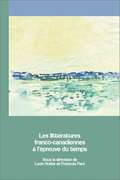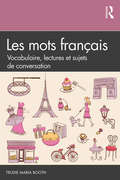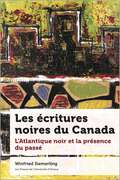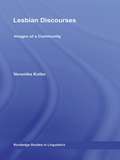- Table View
- List View
Leon Uris: Life of a Best Seller (Jewish History, Life, and Culture)
by Ira B. NadelAs the best-selling author of Exodus, Mila 18, QB VII, and Trinity, Leon Uris blazed a path to celebrity with books that readers could not put down. Uris's thirteen novels sold millions of copies, spent months on the best-seller lists, appeared in fifty languages, and have been adapted into equally popular movies and TV miniseries. Few other writers equaled Uris's fame in the mid-twentieth century. His success fueled the rise of mass-market paperbacks, movie tie-ins, and celebrity author tours. Beloved by the public, Uris was, not surprisingly, dismissed by literary critics. Until now, his own life and work-as full of drama as his fiction-have never been the subject of a book. In Leon Uris: Life of a Best Seller, Ira Nadel traces Uris from his disruptive youth to his life-changing experiences as a marine in World War II. These experiences, coupled with Uris's embrace of his Judaism and desire to write, led to his unprecedented success and the lavish excesses of a career as a best-selling author. Nadel reveals that Uris lived the adventures he described, including his war experiences in the Pacific (Battle Cry), life-threatening travels in Israel (Exodus), visit to Communist Poland (Mila 18), libel trial in Britain (QB VII), and dangerous sojourn in fractious Northern Ireland and the Irish Republic (Trinity). Nadel also demonstrates that Uris's talent for writing action-packed, yet thoroughly researched, novels meshed perfectly with the public's desire to revisit and understand the tumultuous events of recent history. This made him far more popular (and wealthy) than more literary authors, while paving the way for writers such as Irving Wallace and Tom Clancy.
Leon Uris: Life of a Best Seller (Jewish History, Life, and Culture)
by Ira B. NadelThe first biography of the massively popular author of Exodus and Trinity, who &“was as feisty as any of his fictional creations&” (Publishers Weekly). As the #1 New York Times–bestselling author of Exodus, Mila 18, QB VII, and Trinity, Leon Uris blazed a path to celebrity with books that readers couldn&’t put down. Uris&’s thirteen novels sold millions of copies, appeared in fifty languages, and were adapted into equally successful movies and TV miniseries. Few writers equaled his fame in the mid-twentieth century. His success fueled the rise of mass-market paperbacks, movie tie-ins, and author tours. Beloved by the public, Uris was, not surprisingly, dismissed by literary critics. Until now, his own life—as full of drama as his fiction—has never been the subject of a book. Now Ira Nadel traces Uris from his disruptive youth to his life-changing experiences as a marine in World War II. These experiences, coupled with Uris&’s embrace of his Judaism and desire to write, led to his unprecedented success and the lavish excesses of a career as a best-selling author. Nadel reveals that Uris lived the adventures he described, including his war experiences in the Pacific (Battle Cry), life-threatening travels in Israel (Exodus), visit to Communist Poland (Mila 18), libel trial in Britain (QB VII), and dangerous sojourn in fractious Northern Ireland and the Irish Republic (Trinity). Nadel also demonstrates that Uris&’s talent for writing action-packed yet thoroughly researched novels meshed perfectly with the public&’s desire to revisit and understand the tumultuous events of recent history—making him far more popular (and wealthier) than more literary authors—while paving the way for future blockbuster writers such as Irving Wallace and Tom Clancy.
Leonard Cohen and Philosophy: Various Positions
by Jason HoltFrom the early years, when he morphed from celebrated poet to provocative singer-songwriter, to his induction into the Rock and Roll Hall of Fame, Leonard Cohen has endured as one of the most enigmatic and profound figures-with a uniquely compelling voice and unparalleled depth of artistic vision-in all of popular music.<P><P> The aesthetic quality and intellectual merit of Cohen's work are above dispute; here, for the first time, a team of philosophers takes an in-depth look at its real significance.Want to know what Cohen and Kierkegaard have in common? Or whether Cohen rivals the great philosophical pessimist Schopenhauer? Then this book is for you. It provides the first thorough analysis of Cohen from various (philosophical) positions. It is intended not only for Cohen fans but also undergraduates in philosophy and other areas. It explores important neglected aspects of Cohen's work without attempting to reduce them to academic tropes, yet nonetheless will also be useful to academics-or anyone-beguiled by the enigma that is Leonard Cohen.
Leonardo da Vinci (SparkNotes Biography Guide)
by SparkNotesLeonardo da Vinci (SparkNotes Biography Guide) Making the reading experience fun! SparkNotes Biography Guides examine the lives of historical luminaries, from Alexander the Great to Virginia Woolf. Each biography guide includes:An examination of the historical context in which the person lived A summary of the person&’s life and achievements A glossary of important terms, people, and events An in-depth look at the key epochs in the person&’s career Study questions and essay topics A review test Suggestions for further reading Whether you&’re a student of history or just a student cramming for a history exam, SparkNotes Biography guides are a reliable, thorough, and readable resource.
Leopardi and Shelley: Discovery, Translation and Reception
by Cerimonia DanielaGiacomo Leopardi (1798-1837) and Percy Bysshe Shelley (1792-1822) crossed paths during their lifetimes, and though they never met, the legacy of their work betrays a shared destiny. As prominent figures who challenged and contributed to the Romantic debate, Leopardi and Shelley hold important roles in the history of their respective national literatures, but paradoxically experienced a controversial and delayed reception outside their native lands. Cerimonia�s wide-ranging study brings together these two poets for the first time for an exploration of their afterlives, through a close reading of hitherto unstudied translations. This intriguing journey tells the story, from its origins, of the two poets� critical fortune, and examines their position in the cultural debates of the nineteenth century; in disputes regarding translation theories and practices; and shows the configuration of their identities as we understand their legacy today.
Leopardi's Nymphs: Grace, Melancholy, and the Uncanny
by Fabio A. Camilletti"How can one make poetry in a disenchanted age? For Giacomo Leopardi (1798-1837) this was the modern subject's most insolvable deadlock, after the Enlightenment's pitiless unveiling of truth. Still, in the poems written in 1828-29 between Pisa and the Marches, Leopardi manages to turn disillusion into a powerful source of inspiration, through an unprecedented balance between poetic lightness and philosophical density. The addressees of these cantos are two prematurely dead maidens bearing names of nymphs, and thus obliquely metamorphosed into the charmingly disquieting deities that in Greek lore brought knowledge and poetic speech through possession. The nymph, Camilletti argues, can be seen as the inspirational power allowing the utterance of a new kind of poetry, bridging antiquity and modernity, illusion and disenchantment, life and death. By reading Leopardi's poems in the light of Freudian psychoanalysis and of Aby Warburg's and Walter Benjamin's thought, Camilletti gives a groundbreaking interpretation of the way Leopardi negotiates the original fracture between poetry and philosophy that characterises Western culture. Fabio Camilletti is Assistant Professor in Italian at the University of Warwick."
Leopold Von Ranke: A Biography (Routledge Approaches to History)
by Andreas D BoldtLeopold von Ranke endeavoured to understand political order within its own historical context. To understand the nature of historical phenomena, such as an institution or an idea, one had to consider its historical development and the changes it underwent over a period of time. Historical epochs, Ranke argued, should not be judged according to predetermined contemporary values or ideas. Rather, they had to be understood on their own terms by empirically establishing history ‘as things really were.’ Ranke’s influence on History as a modern discipline is thus evident, and this is the first volume in English to chart his life and works for a hundred years.
Les 12 piliers essentiels de la construction de roman: Votre plan pour la construction d’une histoire solide
by C. S. LakinLes 12 piliers essentiels de la construction de roman éliminent le mystère de la construction d'une histoire solide et vous montrent comment passer d'une idée à une œuvre complète en étapes simples et faciles à comprendre. À maintes reprises, les écrivains en difficulté font les mêmes erreurs fatales dans leurs manuscrits. Même les écrivains qui ont étudié les meilleurs livres d'écriture, pris des ateliers et suivi les blogs d'écrivains n'ont toujours pas la structure nécessaire à un bon roman. La vérité est que beaucoup d’écrivains pensent pouvoir écrire un roman sans prendre le temps d’apprendre les rouages de la construction de roman. Tout comme pour la construction d'une maison, les écrivains doivent maîtriser les outils et le matériel appropriés et suivre des règles solides sur le plan structurel s'ils souhaitent « construire un roman ». Les écrivains intelligents prendront le temps d'apprendre à structurer des piliers solides qui soutiendront leurs romans. Ce nouveau livre d’écriture complet décrit clairement comment construire chaque pilier essentiel pour qu’il puisse supporter le poids de votre histoire. Sans ce soutien fondamental, l'effondrement est inévitable. À l'intérieur, vous apprendrez : quels sont les quatre piliers principaux de soutien, et pourquoi et comment devez-vous les construire en premier avant de vous attaquer aux autres composantes de votre roman. comment déterminer si une idée peut potentiellement devenir un concept fascinant avec un coup de fouet et comment transformer cette idée en un concept renversant. quels sont les enjeux majeurs et comment s'assurer que votre roman explose d'enjeux. le secret pour créer un protagoniste fascinant, et les deux objectifs qu'il doit poursuivre. en quoi consiste réellement la tension et comment l'intensifier dans votre roman. la clé pour décrire des lieux évocateurs e
Les Belles Étrangères: Canadians in Paris (Perspectives on Translation)
by Jane KoustasWhile translation history in Canada is well documented, the history of the translation of Canadian fiction outside the nation remains obscure. Les Belles Étrangères examines the translation of Canadian English-language fiction in France. This book considers the history of this practice, the reasons for the move away from Quebec translators as well as the process and perils involved in this detour.Within a theoretical framework and drawing on primary sources, this study considers the historical, theoretical, and concrete aspects of this practice through the study of the translations of authors such as Robertson Davies, Carol Shields, Margaret Atwood, Michael Ondaatje, Ann-Marie MacDonald, and Alistair MacLeod.The book also includes a comprehensive bibliography of English-language novels, poetry, and plays published and translated in France over the past 240 years.
Les Liaisons Dangereuses (Oxford World's Classics)
by Pierre Ambroise Frangoise Choderlos de LaclosOne of the most `modern' of eighteenth-century novels, Les Liasons Dangereuses is the brilliantly observed and vividly rendered story of two libertines and the innocent characters they plot to destroy.
Les Liaisons Dangereuses (Routledge Classics)
by Pierre Choderlos de Laclos‘I resolved to write a book which would create some stir in the world and continue to do after I had gone from it.’ - Choderlos de Laclos A great sensation at the time of first publication, Les Liaisons Dangereuses reads as much the most 'modern' of eighteenth-century novels. Viewed by some critics as a morality tale and others as a subtle inquiry into libertinism, it brilliantly depicts the foibles of the French aristocracy on the eve of the French Revolution. Renowned for its exploration of lust, revenge and human malice, and still carrying a tremendous power to shock, its adaptations for screen and stage have made its central characters notorious for their sophisticated and ultimately tragic games of seduction and manipulation.
Les Littératies: Perspectives linguistique, familiale et culturelle (Collection Questions en éducation)
by Anne-Marie Dionne Marie Josée BergerSignées par des spécialistes provenant de différentes provinces canadiennes, les huit études réunies dans ce volume nous font découvrir que l'acquisition de la littératie est influencée tant par le développement linguistique que l'environnement familial ou la société dans laquelle l'enfant évolue. La littératie — néologisme qui s'intègre graduellement dans le langage de l'éducation —vise à rendre compte du caractère englobant de la langue et de la culture. En effet, la littératie dépasse le simple fait de savoir lire et écrire et renvoie aux capacités de l'individu à maîtriser l'écrit pour penser, communiquer, acquérir des connaissances, résoudre des problèmes, réfléchir sur son existence, partager sa culture et se divertir. L'individu lettré ne peut donc se définir sans l'écrit qui est un atout indispensable pour lire, se lire et lire le monde qui nous entoure. Chaque étude contribue de façon originale à faire comprendre les enjeux essentiels qui influencent la littératie. Publié en français
Les Miserables SparkNotes Literature Guide (SparkNotes Literature Guide Series #41)
by SparkNotesLes Miserables SparkNotes Literature Guide by Victor Hugo Making the reading experience fun! When a paper is due, and dreaded exams loom, here's the lit-crit help students need to succeed! SparkNotes Literature Guides make studying smarter, better, and faster. They provide chapter-by-chapter analysis; explanations of key themes, motifs, and symbols; a review quiz; and essay topics. Lively and accessible, SparkNotes is perfect for late-night studying and paper writing. Includes:An A+ Essay—an actual literary essay written about the Spark-ed book—to show students how a paper should be written.16 pages devoted to writing a literary essay including: a glossary of literary termsStep-by-step tutoring on how to write a literary essayA feature on how not to plagiarize
Les Miserables: Fantine (english Illustrated Version / French Version) (Les\misérables - Complete In Five Volumes. (english / French) -illustrated Ser. #Vol. 1)
by Suzanne UberREA's MAXnotes for Victor Hugo's Les Miserables MAXnotes offer a fresh look at masterpieces of literature, presented in a lively and interesting fashion. Written by literary experts who currently teach the subject, MAXnotes will enhance your understanding and enjoyment of the work. MAXnotes are designed to stimulate independent thought about the literary work by raising various issues and thought-provoking ideas and questions. MAXnotes cover the essentials of what one should know about each work, including an overall summary, character lists, an explanation and discussion of the plot, the work's historical context, illustrations to convey the mood of the work, and a biography of the author. Each chapter is individually summarized and analyzed, and has study questions and answers.
Les Misérables and Its Afterlives: Between Page, Stage, and Screen
by Kathryn M. Grossman Bradley StephensExploring the enduring popularity of Victor Hugo’s Les Misérables, this collection offers analysis of both the novel itself and its adaptations. In spite of a mixed response from critics, Les Misérables instantly became a global bestseller. Since its successful publication over 150 years ago, it has traveled across different countries, cultures, and media, giving rise to more than 60 international film and television variations, numerous radio dramatizations, animated versions, comics, and stage plays. Most famously, it has inspired the world's longest running musical, which itself has generated a wealth of fan-made and online content. Whatever its form, Hugo’s tale of social injustice and personal redemption continues to permeate the popular imagination. This volume draws together essays from across a variety of fields, combining readings of Les Misérables with reflections on some of its multimedia afterlives, including musical theater and film from the silent period to today's digital platforms. The contributors offer new insights into the development and reception of Hugo's celebrated classic, deepening our understanding of the novel as a work that unites social commentary with artistic vision and raising important questions about the cultural practice of adaptation.
Les Saisons class 2 - MIE
by Kaviraj S. Peedoly"Les Saisons", écrit par Kaviraj S. Peedoly et illustré par William Rasoanaivo, est une ressource éducative dynamique conçue pour les élèves de deuxième année à Maurice. Ce livre géant interactif vise à favoriser le développement de la littératie à travers des activités de classe engageantes. L'histoire suit Jamel et Aaliya alors qu'ils naviguent à travers les saisons contrastées, exprimant leurs préférences et expériences respectives. En discutant de leurs points de vue sur l'hiver et l'été, le récit suscite des discussions sur les expériences personnelles liées aux saisons parmi les élèves. Le livre encourage la participation active, incitant les élèves à partager leurs rencontres saisonnières, renforçant la compréhension à travers la narration et des exercices stimulants. Avec une approche structurée en trois sessions, ce livre favorise l'acquisition linguistique et les compétences de réflexion tout en soulignant l'importance des différentes littératies, à la fois en classe et au-delà, pour faciliter la progression scolaire fluide des jeunes apprenants à Maurice.
Les Sauvages Américains
by Gordon M. SayreAlgonquian and Iroquois natives of the American Northeast were described in great detail by colonial explorers who ventured into the region in the seventeenth and eighteenth centuries. Beginning with the writings of John Smith and Samuel de Champlain, Gordon Sayre analyzes French and English accounts of Native Americans to reveal the rhetorical codes by which their cultures were represented and the influence that these images of Indians had on colonial and modern American society. By emphasizing the work of Pierre Franaois-Xavier Charlevoix, Joseph-Franaois Lafitau, and Baron de Lahontan, among others, Sayre highlights the important contribution that French explorers and ethnographers made to colonial literature. Sayre's interdisciplinary approach draws on anthropology, cultural studies, and literary methodologies. He cautions against dismissing these colonial texts as purveyors of ethnocentric stereotypes, asserting that they offer insights into Native American cultures. Furthermore, early accounts of American Indians reveal Europeans' serious examination of their own customs and values: Sayre demonstrates how encounters with natives' wampum belts, tattoos, and pelt garments, for example, forced colonists to question the nature of money, writing, and clothing; and how the Indians' techniques of warfare and practice of adopting prisoners led to new concepts of cultural identity and inspired key themes in the European enlightenment and American individualism.
Les estructures elementals de la narrativa
by Albert Sánchez PiñolEl secret de les grans històries: un llibre indispensable per gaudir encara més de les lectures, les pel·lícules i les sèries. Aquest llibre no explica com s’escriu una història; aquest llibre explica com s’escriuen totes les grans històries que s’han escrit i que mai s’escriuran, i per què han captivat milions i milions de lectors. És una afirmació tan rotunda com certa. I per què cal llegir aquest llibre? De ben segur, per dos motius. Primer, perquè aquells que comencen a escriure no hagin de passar pel mateix suplici que va haver de patir al començament l’autor de novel·les tan populars com Victus o La pell freda. I segon, i més important, perquè els lectors de Les estructures elementals de la narrativa gaudiran el doble de les lectures, de les pel·lícules i de les sèries televisives. Per què ens agraden tant, les bones històries? Com s’imaginen i es creen des del no-res? Com es desenvolupa un argument? Com s’articula correctament una trama? Com ha de començar i acabar una història perquè sigui reeixida? Són preguntes cabdals, perquè, en contra de la percepció més generalitzada —que considera les històries com una eina d’oci sense transcendència—, el fet és que sense narrativa moriríem. Els relats no ens fan ser millors persones, sinó que exerceixen una funció superior: ens fan persones. Penseu en la vostra infància i en els textos que us explicaven com era el món. O en els somnis: el fet narratiu és una pulsió tan poderosa que cada nit... ens expliquem històries a nosaltres mateixos! Per això, a cavall de l’antropologia i partir d’exemples molt diversos —dels relats dels mbuti africans a La metamorfosi de Kafka, de Moby Dick de Melville al Tiburón de Spielberg, del Quixot a Joc de trons, entre d’altres—, Les estructures elementals de la narrativa revela amb enginy i amenitat el secret de tots els relats que, en paraules de l’autor, «fan d’aquest món, abismalment horrorós, un lloc suportable».
Les fables canadiennes de Jules Verne: Discorde et concorde dans une autre Amérique (Amérique française)
by Gérard FabreEn trois décennies, du début des années 1870 au tournant du XXe siècle, Jules Verne écrit trois romans couvrant plus d’un demi-siècle d’histoire canadienne. Si ce triptyque peut être saisi dans le processus global de la création vernienne, il forme en même temps une entité à part entière, un formidable révélateur de la place du Canada et du Québec en France. Cette place est relative : elle dépend beaucoup de ses interactions avec l’Angleterre et les États-Unis. Plusieurs oeuvres de Verne, depuis Les Aventures du Capitaine Hatteras, publiées au milieu des années 1860, s’attachent à comparer les réactions de personnages anglais et américains. Il en ressort in fine une rivalité des deux pays, comme dans les romans canadiens Le Pays des fourrures (1872-1873) et Famille-Sans-Nom (1889). Le conflit anglo-américain explique les connivences entre Canadiens français et Américains, dont font état ces deux romans. Or, à la fin de sa vie, Verne remanie ce système d’alliance. Dans Le Volcan d’or, rédigé en 1899-1900, les relations vont diamétralement changer : Canadiens français et anglais, tous honnêtes gens en quête de l’or du Klondike, s’unissent contre des Américains originaires du Texas, délinquants notoires et redoutés. Comment analyser ce retournement? Quelle clé offre-t-il pour comprendre, à une plus vaste échelle, les images du Canada et du Québec qui prévaudront dès lors en France? Ce livre est publié en français. - Over the course of three decades—from the early 1870s to the turn of the 20th century—Jules Verne wrote three novels covering more than half a century of Canadian history. While this triptych is undoubtedly located within the Vernian corpus, it nevertheless constitutes a body of work in its own right, a powerful testimony to the place that Canada and Quebec occupied in France. This place was relative, however, dependent on interactions with England and the United States. Several of Verne’s works beginning with the publication of The Adventures of Captain Hatteras in the mid-1860s compare English and American characters. Ultimately, the rivalry that emerges between the two countries is further developed in the Canadian novels The Fur Country (1872–1873) and Family Without a Name (1889). The Anglo-American conflict explains the affinities between French Canadians and Americans present in both novels. Toward the end of his life, however, Verne revisits this alliance. In The Golden Volcano, written in 1899–1900, those relations change diametrically: French and English Canadians, all honest people in search of Klondike gold, unite against the Texans, notorious and feared delinquents. How is this reversal to be understood? What clues does it offer for understanding of the depictions of Canada and Quebec that prevail henceforth in France on a broader scale? This book is published in French.
Les fables de Jean de La Fontaine: Livre premier
by Jean de La Fontainelivre premier : La Cigale et la Fourmi Le Corbeau et le Renard La Grenouille qui veut se faire aussi grosse que le boeuf Les deux Mulets Le Loup et le Chien La Génisse, la Chèvre, et la Brebis en société avec le Lion La Besace L’Hirondelle et les petits Oiseaux Le Rat de ville et le Rat des champs Le Loup et l’Agneau L’Homme et son Image Le Dragon à plusieurs têtes et le Dragon à plusieurs queues Les voleurs et l’Âne Simonide préservé par les Dieux La Mort et le Malheureux La Mort et le Bûcheron L’Homme entre deux âges et ses deux Maîtresses Le Renard et la Cigogne L’Enfant et le Maître d’école Le Coq et la Perle Les Frelons et les Mouches à miel Le Chêne et le Roseau
Les littératures franco-canadiennes à l’épreuve du temps (Archives des lettres canadiennes)
by Lucie Hotte & François ParèFinaliste, Prix du Canada 2018, Fédération des sciences humaines « Les littératures de l’exiguïté, dont font partie les ensembles littéraires franco-canadiens, restent fascinées par les sémantiques de l’espace. Elles en oublient leur longue histoire et renoncent, par-là, aux riches taxonomies liées au passé collectif et à la mémoire, tant elles s’entêtent à coïncider avec les territoires imaginés, géographiques et identitaires, où elles s’inscrivent. » Lucie Hotte et François Paré ont réuni des études qui témoignent du dynamisme de l’activité littéraire franco-canadienne marquée par l’histoire, mais aussi représentative de l’image que chacune des collectivités se fait d’elle-même et de son avenir. Les œuvres analysées illustrent la recherche esthétique d’une grande originalité, menée par les écrivains franco-canadiens dans des conditions souvent difficiles sur le plan des institutions littéraires et des moyens de publication ou de diffusion. Cet ouvrage réunit les textes de Marie Carrière, Jeanette den Toonder, Grégoire Holtz, Lucie Hotte, Kathleen Kellett, Louise Ladouceur, Jean Morency, François Paré, Pamela V. Sing, Jimmy Thibeault et Emmanuelle Tremblay. En somme, une multiplicité de regards et une synthèse unique sur la francophonie canadienne durant plus de quatre siècles d’écriture. Une coédition avec le Centre de recherche en civilisation canadienne-française. By gathering studies on the French-Canadian literary activity of the last four centuries, Lucie Hotte and François Paré have managed to create a dynamic fresco in which a multitude of points of view – from Marie Carrière to Jimmy Thibeault, Grégoire Holtz, Louise Ladouceur or Jean Morency – manage to create a unique synthesis of the history and styles that characterize the literatures of exiguity (those in a language-minority context). Publié en français
Les mots français: Vocabulaire, lectures et sujets de conversation
by Trudie Maria BoothLes mots français: Vocabulaire, lectures et sujets de conversation presents a clear, thorough and systematic overview of modern French vocabulary on a variety of subjects. Written in the target language, each of the 32 chapters is divided into the following sections, with translations into English to facilitate the learning process: • basic vocabulary (vocabulaire de base) • additional vocabulary (vocabulaire supplémentaire) • related vocabulary (vocabulaire apparenté) • idiomatic expressions, sayings and proverbs (proverbes et expressions) • cultural readings (lectures). The book includes a range of communicative exercises and sample sentences, while an answer key and flashcards are available online. This is essential reading for learners at level A2–C2 of the Common European Framework for Languages, and Intermediate Mid–Advanced on the ACTFL proficiency scales.
Les écritures noires du Canada: L'Atlantique noir et la présence du passé (Études canadiennes)
by Winfried SiemerlingThe Black Atlantic Reconsidered is the first comprehensive work to explore Black Canadian literature from its beginnings to the present in the broader context of the Black Atlantic world. Winfried Siemerling traces the evolution of black Canadian witnessing and writing from slave testimony in New France and the 1783 "Book of Negroes" through the work of contemporary black Canadian writers including Austin Clarke, George Elliott Clarke, Dionne Brand, Wayde Compton, and Esi Edugyan.Arguing that Black writing in Canada is deeply imbricated in a historic transnational network, Winfried Siemerling explores the powerful presence of Black Canadian history, slavery, the Underground Railroad, and the Black diaspora in the work of contemporary Black Canadian writers.Individual chapters examine the literature that has emerged from Quebec, Nova Scotia, the Prairies, and British Columbia, with attention to writing in both English and French.
Lesbian Discourses: Images of a Community (Routledge Studies in Linguistics #Vol. 9)
by Veronika KollerLesbian Discourses is the first book-length treatment of lesbian text and discourse. It looks at what changing images of community American and British lesbian authors have communicated since 1970, how this change can be traced in texts such as pamphlets, magazines and blogs, and why this change has taken place. At the heart of the book is a detailed linguistic analysis, which is embedded in a discussion of the relevant socio-political contexts and discourse practices, and supplemented by interview data. The book can more generally be read as an example of how to do textual analysis in social research, in particular how to engage in the discourse-historical and socio-cognitive study of collective identity. Despite its text-centered approach, the book avoids being overly technical and will therefore be of interest not only to postgraduate students and researchers in linguistics but also to those in anthropology, history and sociology, especially women’s/gender studies.
Lesbian Images: Essays (The\crossing Press Feminist Ser.)
by Jane RuleJane Rule&’s fourth book explores lesbianism as portrayed by authors from Gertrude Stein to Colette, from Vita Sackville-West to May Sarton and Willa Cather Lesbian Images opens with a disclaimer from the author: &“This book is not intended to be a comprehensive literary or cultural history of lesbians.&” Rather, as Jane Rule goes on to tell us, her goal is to present her own attitudes and measure them against the images of lesbianism as depicted by other female authors. Thus, chapters titled &“Gertrude Stein 1874–1946,&” &“Willa Cather 1876–1947,&” and &“Ivy Compton-Burnett 1892–1969,&” among many others, reveal how the concept of love between women can be filtered through one&’s personal experiences and perceptions. There are also chapters about lesbian myths and morality; the effect of the women&’s movement on lesbianism; the inherent conflicts between lesbianism and feminism; how Radclyffe Hall&’s The Well of Loneliness changed fifteen-year-old Rule&’s life; and what it means to be labeled a lesbian writer. At once astute and nonjudgmental, Lesbian Images is a deeply engaging work that sounds a powerful note of hope for the future.
